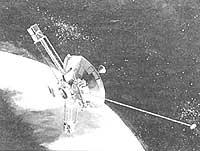Pluto: a planet from the cold
1990/02/01 Henbest, N. Iturria: Elhuyar aldizkaria

About sixty years ago, a young astronomer from Arizona began exploring the sky. Their goal was to find a new planet, something that in the last thousands of years had achieved twice. Within a year, Clyde Tombaugh discovered the new planet he was looking for. After looking at the photographic images of two million stars, he found a “star” with movement. It was the planet we know today as Pluto and it was beyond the known borders of the Solar System.
Since its discovery it has given more perplexity and more headaches than any other planet.
Today there are astronomers who do not think it is so appropriate to call it a planet: perhaps it would be more appropriate to treat it as a large asteroid.
Tombaugh believes it is the planet Pluto. He is convinced of this and the International Astronomical Society coincides with it. Therefore, there are officially nine planets in the Solar System. The first six planets, from Mercury to Saturn, have been known since prehistory. In 1781, an amateur astronomer named William Herschel discovered what we know today as Uranus. And in 1846, Johann Galle, an astronomer at the Berlin Observatory, discovered Neptune.

In the following years, neither Neptune nor Uranus realized that they did not always follow the same orbit, and astronomers suspected that the ninth planet existed. American astronomers Pickering and Lowell predicted that, beyond Neptune's orbit, there was a planet that weighed several times more than the Earth.
Lowell built an Arizona Flagstaff observatory to study Martitz’s “canals” and used his telescopes to search for the predictable “Planet X” until his death in 1919.
To extract photographic plates that could demonstrate the existence of “planet X” in 1929, the observatory built a new telescope. The director hired Tombaugh to hold a heavy exhibition of plates every night and analyze them daily.
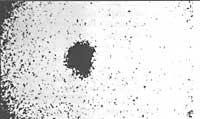
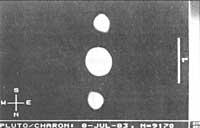
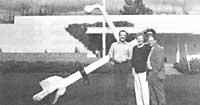
Tombaugh’s job was to compare plates extracted a few days earlier to see if there were “stars” moving. By 1930, Tombaugh was looking among the stars of Gemini. Suddenly, he realized that a point of light was moved between two plates extracted six nights earlier. The name of the god of the species of fauna seemed appropriate for this planet, exiled on the dark side of the Solar System.
Tombaugh found this point a few degrees from the position suggested by Lowell for Planet X. In addition, Pluto's orbit was very similar to that of the planets predicted by Lowell and Pickering.
But there was a problem: Pluto was a much slower light than Planet X should be. This was why astronomers have been put aside. It could not really be said that Planet X foreseen in Pluto was the same.
The answer was found in 1978. Astronomer Jim Christy thought of reviewing some of the photographs that had previously been discarded, as Pluto's image was stretched, as if during the exhibition the telescope had moved unexpectedly. Christy realized that while the well-defined and circular stars appeared on the plates, only Pluto appeared stretched. This elongated image was the result of two cascading images: A member of Pluto and slower light. Christy studied the plates extracted a few years earlier and discovered the same type of image. Bob Harrington, Christy's partner, and Christy himself discovered that these images correspond to a moon that spends a week approximately turning to Pluto at 20,000 kilometers.
Based on the gravitational law of Newton, Christy and Harrington immediately discovered Pluto and the combined mass of their moon. This mass was found around 1/500 of the Earth's mass. Lowell's Planet X should be much heavier than Earth to influence Uranus and Neptune. Pluto was therefore not “Planet X”.
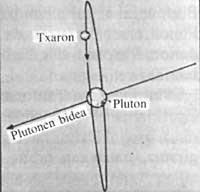
Christy, the discoverer of the new satellite, named the satellite “Txaron” in honor of his wife Charlene.
Since the first photos of Pluto and Txaron were taken, some astronomers have obtained images in which both bodies appear separate. This shows us that both have a similar size. Most satellites are the size of a small percentage of the parent planet, except for a quarter of the size of the Earth. The diameter of Txaron is half that of Pluto. Consequently, the planet and its moon have their orbit around a common center of gravity that lies between them.
As our Moon always has the same face towards Earth, Txaron always has the same face looking at Pluto. In both cases, the gravitation of the planet stops the rotation of the satellite, being obliged to maintain the same orientation with respect to the planet. Being so big with Txaron Pluto, it also slows Pluto, so the Pluto side always looks at Txarón.
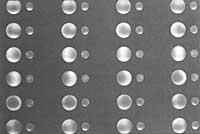
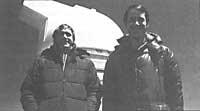
Pluto and Txarón's orbit of the solar plane is very inclined. Looking from the ground, we sometimes see the orbit in an almost horizontal plane, giving the feeling that both bodies revolve in a circle. But sometimes we don't see it that way. Pluto and Txaron go before baptism, as if one of them was the orbit of the other. Hideouts, or the season in which one passes in front of the other, take place every 124 years (half the time Txaron and Pluto spend turning the sun) and last five years.
In March 1985, astronomers discovered that the edge of one's orbit cut the edge of the other's orbit. They saw one body hiding more and more from the other, until in 1987 and 1988 it was completely hidden behind Txaron Pluto, the furthest part of the orbit. In the closest part of each orbit, Txaron passed full ahead of Pluto, hiding part of Pluto. For October both will appear in sight, XXII. Until the 20th century.
When Pluto starts hiding in Txaro, or vice versa, all of the system's light must dim.
Measuring exactly how long it takes since the system begins to subside until it returns to shine, Buie, an astronomer operating at the Baltimore Institute of Science, has calculated the size of both bodies. The precision of the technique surprises us more than the results, since it measures the size of the bodies 4 billion kilometers away with a precision of few kilometers.
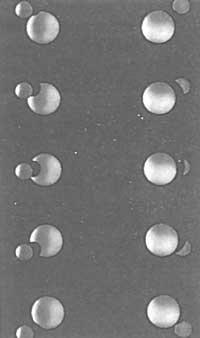
Pluto has a diameter of 2284 kilometers, while Txaron is half the size of Pluto, specifically 1192 kilometers. Pluto has two thirds of the diameter of the Moon.
Despite knowing the diameters of Pluto and Txarón (each), the characteristics of the orbits only allow you to know the whole mass of the system.
Based on the data provided by the Voyager spacer on the density of satellites, astronomers believed that Pluto was mainly composed of iced water or methane ice, but in large proportion Pluto has stone. Researching more precisely, that's what they've discovered, is that three-quarters of Pluto are stones and most of the other quarter is icy water and methane in a small percentage.
The occultation between Pluto and Txaron allows astronomers to map the surface characteristics of the two worlds for the first time. Again, they must accurately measure the system light. Although at first it seems a very simple technique, it takes a large computer capacity to convert the observations on Pluto and Txarón into maps. Buie has used the so-called “most entropiagente method”.
Considering what appears on the first map of Pluto, the planet presents bright helmets at the poles, probably composed of iced methane. They are three or four times brighter than the darkest part of the equator. The area of the equator is reddish.
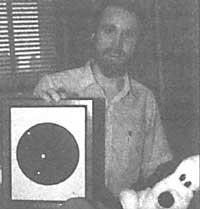
Buie advises to be careful when interpreting the dark and bright areas of the equator. In his opinion, Pluto's spots are related to the number of superficial methanes. A slight increase in temperature allows evaporation of the large number of surface methanes of Pluto.
Two different worlds
Txaron and Pluto, according to Buie, are quite different. Txaron is much more uniform. It is believed that it has no polar helmet and there are no bands in the equator. The most characteristic feature in latitudes is that these are bands corresponding to areas of the Earth: in a dark band hemisphere and in the other bright band hemisphere.
Infrared radiation has also been studied and differences have been found between Pluto and Txaron. Since both bodies are so close to the stack, it is almost impossible to separate the infrared spectrum of Pluto from the spectrum of Txaron.
As expected, Pluto's infrared spectrum showed large lines of methane. But Txaron did not show traces of methane, but an evident line of two microns, characteristic of icy water. It is similar to the spectra of icy moons of Jupiter, Saturn and Uranus. For Buie, Txaron and Pluto they could initially have a similar (metanous) surface. Due to the lower severity of Txarón, his initial methane fled into space, leaving the icy water layer in sight. Therefore, as Pluto can expect sunlight to reflect better than Txarón, and as can be seen by analyzing the amount of light reflected by each body, Pluto reflects half the amount of light it receives and Txaron only one third.
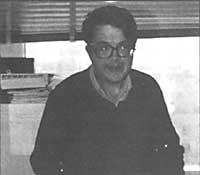
Observations were also made on the atmosphere of Pluto, which showed two distinct zones. The highest layer is about 300 kilometers thick. Below is the layer of vaults of 46 kilometers of minimum thickness.
The pressure exerted by Pluto's atmosphere is about millions of that exerted by the Earth, but the extension of the outside of the atmosphere to the size of Pluto is enormous. Although Pluto has a fifth of the Earth's diameter, its atmosphere is double. Astronomer Elliot, a wise astronomer who has participated in numerous observations, states that the atmosphere may have some methane, but it is not necessarily the main ingredient. The main components could be nitrogen or argon. From the observations data, the atmosphere consists of methane (68 K) or mainly nitrogen (107 K).
Currently, researchers try to figure out what happens in the lower part of the shrimp layer. Both Pluto and Txaron have been measuring their exact position (not only about each other but also about the stars that are further behind). And as a result of these measurements, the result is that, taking into account all the mass that has been called the duplicate planet, Pluto has a smaller part than expected. This means that Pluto has less density or that she is less than previously thought.

The 1980s and early decade are ideal for studying the atmosphere in Pluto. Pluto has a long orbit around the sun and passed through the nearest point in September last year. Since 1979 Pluto is closer to the Sun than Neptune, a situation that will remain until 1999. Some researchers have analyzed that the density and atmospheric extent of Pluto depends largely on the distance to the sun. At the furthest point of the Sun, the atmosphere condenses to the surface in the form of metallic snow. Every time it approaches the sun, a proportion of methane evaporates forming the atmosphere.
Pluto's strange orbit has surprised the astronomer since the 1930s. Seeing that it crosses the orbit of Neptune, how are they not touched or as a consequence of the gravity of Neptune, how does it not come out of the Solar System? Astronomers have asked themselves questions like these. It occupies an orbit around the Sun 1.5 times more than the time Neptune spends. Whenever Pluto is close enough to the Sun, Neptune is in its orbit far from Pluto, so there is no danger. In addition, we have already said that Pluto has the inclined orbit, so in periods close to the Sun it is below the plane of Neptune.
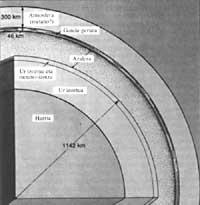
Until now, astronomers could say little about the origin and future of Pluto. Until it was discovered in Txaro, many astronomers believed it was the moon of Pluto Neptune (moon escaped from the orbit around Neptune). But the idea that Pluto and Txaron had escaped Neptune did not seem credible and rejected that idea. Astronomers believe that, based only on its orbit, it cannot be said that Pluto has formed in that same orbit that is now circulating, or that, on the contrary, it has formed in another orbit and has moved by the gravitational force of other planets.
To learn a little more about the formation of Pluto, the most interesting thing is to compare its composition with that of other external bodies of the Solar System. Travelling to Pluto is something astronomers have mentioned, but it seems like a dream, according to Buie. This probe would take 60 to 70 years to reach the goal. However, today astronomers are also discussing the characteristics of spaces that would need much less time for this trip.
One of the reasons why space is sent to planets is to understand its development and the configuration of the Solar System, thus discovering some clarity in understanding the processes that planets can generate around the history and stars of our Earth.
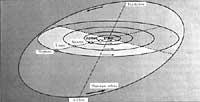
Recent observations on Pluto indicate that it can be a new type of world. Different from the stone planets closest to the Sun and different from the gaseous giant planets. It seems not like the ice moons of the outer planets. Far from the heat of the central star in the Solar System, Pluto could be the only object that will tell us how a planet forms at distant distances from the planetary system. Although only for this reason, it is worth the exploration to continue.

Gai honi buruzko eduki gehiago
Elhuyarrek garatutako teknologia




